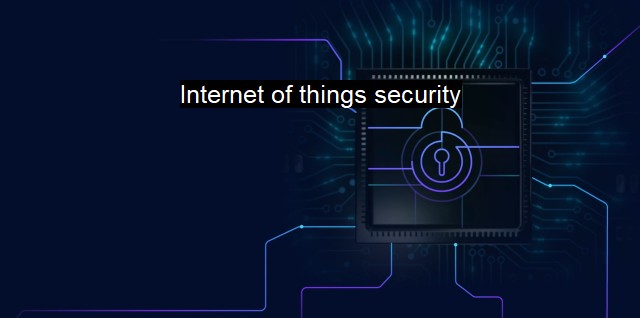What is Internet of things security?
Securing the Future of IoT: Challenges and Solutions for Connected Devices
The Internet of Things (IoT) typically denote a network of interconnected physical devices, software applications, and other entities capable of collecting and sharing data in real-time. This term essentially refers to any object with an internet-enabled operation, including everyday items such as refrigerators, TVs, thermostats, or even cars. For instance, an individual could interact with their home's IoT-empowered devices via a smartphone, while business owners of all sizes could increase productivity and reliability using IoT.IoT has undeniably enriched lives and increased corporate efficiency, although it has the potential to render peaceful moments into mayhem if its safety aspect, which is IoT security, is taken for granted. Consequently, IoT security, while often ignored, plays a significant role.
IoT Security refers to safeguarding associated IoT devices and networks against prospective cyber security threats. The exponential growth of the Internet of Things and its integration into life has resulted in a broader strike area for hackers and cyber criminals. The scale of these cyber attacks ranges from the minute pranks to a sizeable harmful blow affecting public safety. For instance, a compromised Internet-enabled refrigerator could cause slight inconveniences like wrongly timed defrosting, whereas a hacked nuclear power station could result in alarming situations.
This diversity of harm scale accelerates the urgency for comprehensive IoT security. IoT security's significance is emphasized by the growing reliance on connected devices, which manage essential, sensitive data from personal health records to national defense mechanisms. Also, malware threats targeting IoT devices records a significant increase recently, turning home networks into absurdly ordered botnets committing DDoS attacks.
Then comes the role of cybersecurity mechanisms and antivirus ensure the safety of IoT networks. Such solutions protect IoT devices by detecting and preventing prospective intrusion attempts or blocking access to unsafe websites, leading to potential threats. What further complicate matters are the variables and complexities associated with remedying IoT vulnerabilities. Also, fueling the problem is the lack of standards in the classification for IoT device capabilities and data privacy measures within these devices.
A robust IoT security framework implies strict data and user identity protection, encrypted communications and a continual check for vulnerabilities. It implies the development of assorted protection strategies at various layers, such as the application, network, and physical levels. Cybersecurity companies have been exploring various mechanisms to secure IoT devices, such as employing Artificial Intelligence, Blockchain, Machine Learning, and other cutting-edge technologies. All these efforts result in an IoT-security approach that can recognize, dismiss, and define the effect of an extensive array of network interactions and anomalies.
Users need to be diligent with their own IoT device security practices. They should be aware of what data their implement transacts, and apply regular software updates. Also, fortifying their Wi-Fi network, putting up secure passwords, and disabling non-essential features would go a long way in maintaining the Internet of Things' security integrity.
Nonetheless, bridging this vast IoT security contradiction is cumbersome but not unfeasible. Integrated digital security, combined with savvy businesses and receptive regulators, will eventually restore the much-needed supremacy of sense and safety in a complex, connected living environment. Such a mindset will ensure that businesses and consumers are liberated to experience the current and future potential of IoT, instead of becoming cybercrime victims.
As a conclusion, the Internet of Things security should be a priority for everyone, from individual users to large corporations, to prevent against cyber threats. IoT's omnipresence life sectors is anticipated, and a unified diligence from all counteracting bodies, including manufacturers, security firms, and users, is integral for maintaining security committed IoT existence.

Internet of things security FAQs
What is the Internet of Things security?
The Internet of Things security refers to the measures taken to protect internet-enabled devices and networks from cyber-attacks and data breaches. It involves securing the devices themselves, the data they collect and transmit, and the networks they use to communicate.What are the risks associated with the Internet of Things security?
The Internet of Things security risks include unauthorized access to devices and networks, data breaches, theft or loss of data, denial-of-service attacks, and malware infections. With the increasing number of internet-connected devices, the attack surface is also growing, making IoT systems a prime target for cybercriminals.What are some best practices for securing the Internet of Things?
Some of the best practices for securing the Internet of Things include keeping devices and software up to date, changing default passwords, using strong passwords, implementing two-factor authentication, encrypting data, restricting network access, monitoring device behavior, and having a response plan in place in case of a cybersecurity incident.What is the role of antivirus software in securing the Internet of Things?
Antivirus software can play a role in securing the Internet of Things by protecting devices from malware infections. However, it's important to note that traditional antivirus solutions may not be effective against all types of threats, and IoT devices may have limited processing power and memory, making resource-intensive software impractical. As a result, specialized security solutions designed for IoT devices may be necessary to protect against emerging threats.| | A | | | B | | | C | | | D | | | E | | | F | | | G | | | H | | | I | | | J | | | K | | | L | | | M | |
| | N | | | O | | | P | | | Q | | | R | | | S | | | T | | | U | | | V | | | W | | | X | | | Y | | | Z | |
| | 1 | | | 2 | | | 3 | | | 4 | | | 7 | | | 8 | | |||||||